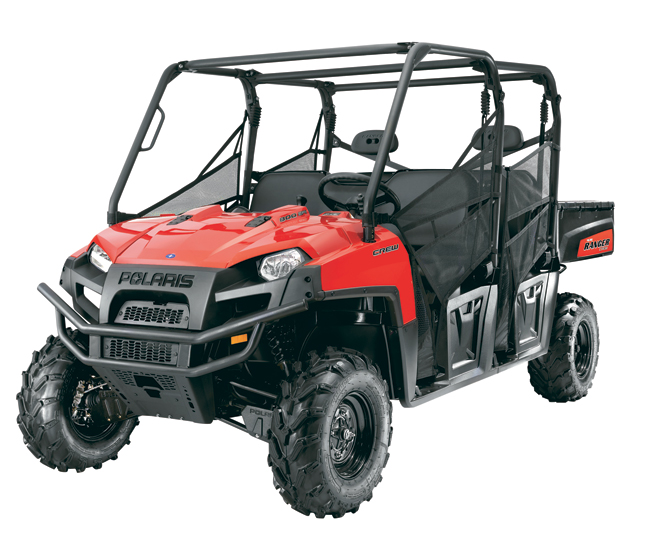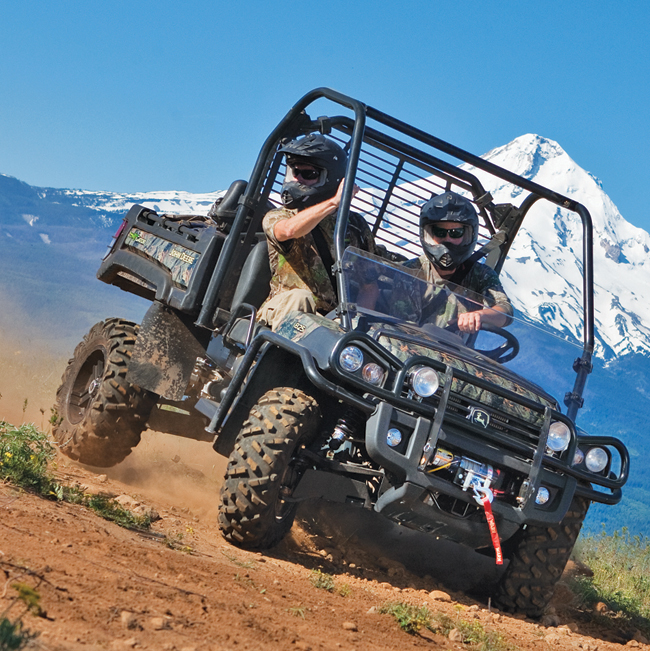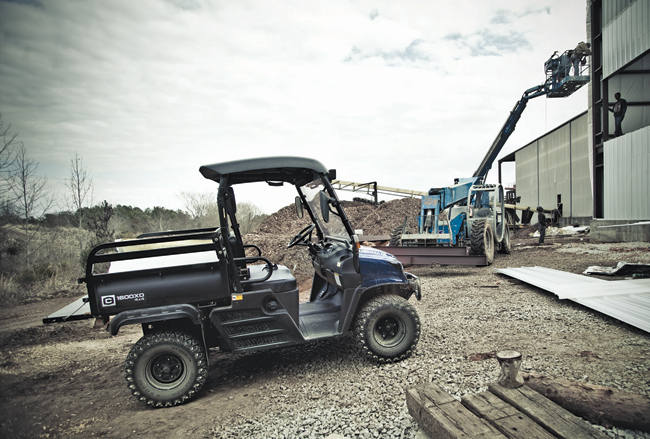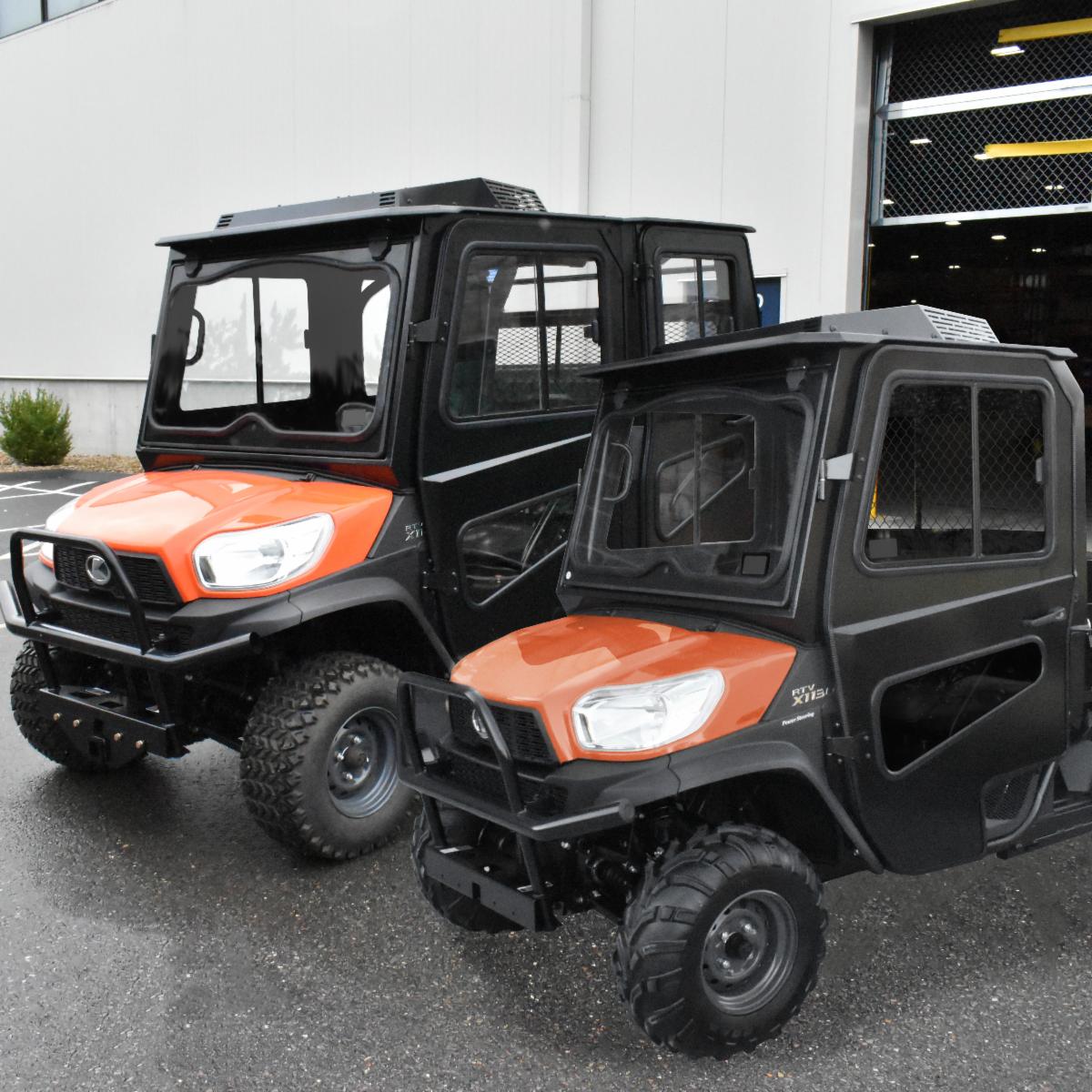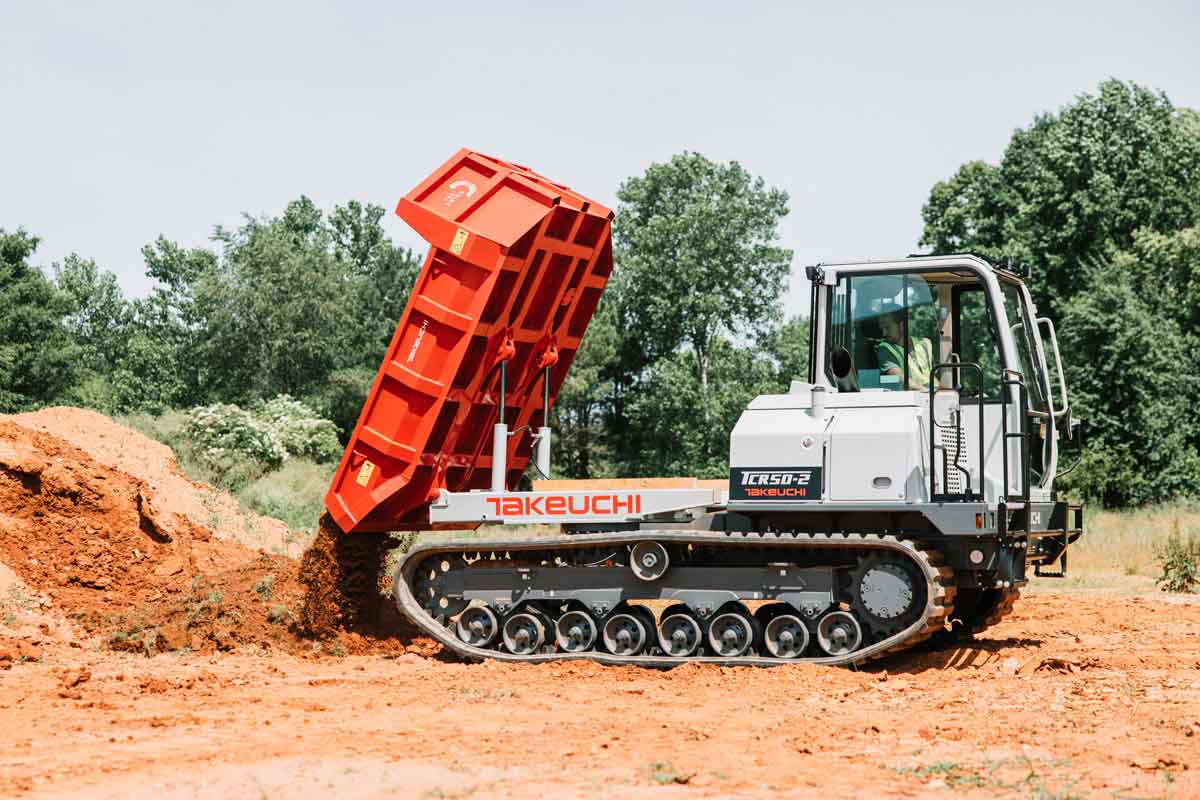Purpose Driven
Not all projects have paved roads. Pipeline construction, solar farming, university grounds keeping, raising cattle — these are all unique industries and applications, but they all share a common need for long-distance, off-road transportation. Traditional trucks are the obvious go-to tool for most trade professionals. Load up your bed, throw a few fellas in the backseat and truck off to your next project site. Unfortunately, certain terrain can’t be conquered by a typical vocational truck.
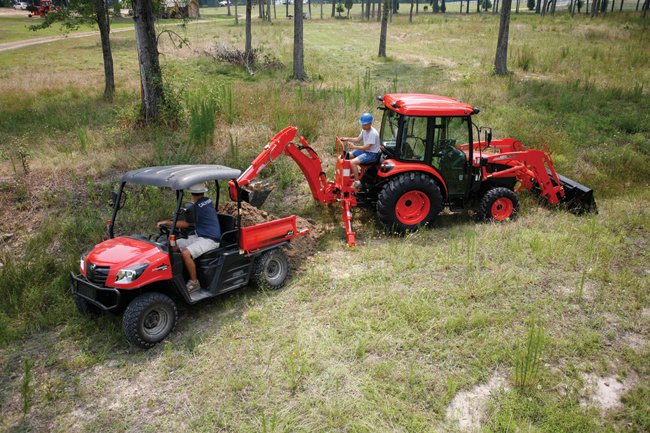
For such all-terrain trucking, a utility vehicle (or UTV for short) is one of the most versatile tools for professional contractors. Similar to their ATV cousins, UTVs are made for off-road applications, but differ in that they can take at least two to six passengers and have a bed for cargo, supplies or spoils. UTVs are specially engineered to traverse both inhospitable, off-road jobsites and finely-manicured, hard-to-access public areas. It’s a machine utilized by a diverse crowd of owners and operators — from farmers and foremen to hunters and off-road enthusiasts.
“Every market segment has its unique characteristics and requirements,” explains Michael Chandler, sales manager for JCB, which just released its WORKMAX UTV to the market this spring. “But that’s the beauty of a UTV — the multitude of available accessories to customize each individual unit to that need. For instance, the hunter can add gun racks, a snow specialist can add a snowplow and landscapers can add sprayers to the bed for weed and pest control. All of the limitless possibilities are customized around a standard spec machine.”
Today, companies such as John Deere, Bobcat, Kawasaki, Kubota, Polaris, KIOTI, Cushman and now JCB manufacture a variety of 2×4, 4×4, 6×4 and 6×6 variations for both the commercial and recreational markets. From the start, manufacturers seem to move in those two separate markets — commercial and recreation. While most UTVs can do both, there are definitely certain brands aimed at each market. Companies like Polaris, Yamaha and Honda are usually more focused on the consumer recreational markets, while work-minded equipment manufacturers like Bobcat, Kubota and the JCB WORKMAX are mostly aimed at creating an all-terrain work truck for commercial purposes. Brands like KIOTI, John Deere and Case IH seem to land somewhere in between.
Step onto a dealer lot and you’ll immediately see the big difference between the two types — recreational-style UTVs go very fast (up to 60 mph), while commercial UTVs usually go about 25 mph (the ideal top speed for a construction site). There are a lot of other differences as well — diesel engines, wet disk brakes, power steering, electronic fuel injection, hydraulic bed lifts, enclosed cabs, specialty aftermarket outfitters and a whole slew of innovative suspensions and attachments that are often associated with commercial grade utility vehicles. So where do you start?
“You first need to determine if the vehicle will be used for work or play,” says Dan Muramoto, product manager with Kubota (the famous orange brand that basically started the diesel UTV market). “There are a number of UTVs that are specifically targeted for recreational purposes, but are then limited in their utility capabilities. For commercial applications, you really need a commercial workhorse. Some other considerations to take into account are diesel versus gas-powered engines, cargo capacity versus passenger capability and the availability of implements.”
Preparing for the Road Ahead
Considering the major commercial segments for utility vehicles, which is the focus of this article, parks, universities, governmental agencies, landscapers, farmers and general construction contractors are the most popular markets for professional utility vehicles. Of course even these pros often like to have a little fun. A farmer or rancher may own a utility vehicle that they use to load tools, bring lunch to the harvesting crew, repair fences and herd cattle. Then they’ll use the same vehicle to ride trails and go hunting and fishing. Sometimes it’s hard to classify users as simply recreational or commercial.
But clearly, there has been growth in machines built for both applications. According to the industry manufacturers we surveyed, experts estimated that North American sales of utility vehicles are in the 250,000 to 280,000 units-per-year range today, but only about 25 to 30 percent of those units go into commercial applications. It appears that 4x4s have the lion’s share of the market, while gas accounts for about 75 percent of the market and diesel accounts for the other 25 percent.
“The biggest choice would be the preferred power source — gas or perhaps a diesel-powered UTV,” explains Chris Austinson, utility vehicle product specialist with Bobcat Co., which currently offers 12 models of utility vehicles. “Buyers should be comparing the specifications which are most important to them and how they intend to use the vehicle. I see the marketplace choosing gas power as the most preferred source of power for this product.”
It’s safe to say utility vehicles are used by customers in both gas and diesel markets. They also come in a wide range of prices — from $5,000 to $60,000 — which probably means there is an exact UTV for your project and pocketbook. There are a variety of brands and models in the industry, and many of them offer similar technologies and options. For instance, there are typically two types of seating selections on utility vehicles — two bucket seats or bench seating. Bench seating offers the opportunity for three passengers to ride, while bucket seats are, well, just more comfortable. Also on the grow are multi-seating utility vehicles, which add an extra row of seating (see the sidebar to the right).
“To some extent multi-seat vehicles are a growing market,” says Muramoto. “The segments that are driving these markets are primarily consumers and not commercial users, but there are limited opportunities for work crews in the municipal and industrial markets and among farmers and ranchers.”
Besides seating, an initial big option will be drivetrain; 2×4, 4×4, 6×4 and 6×6 utility vehicles are all available on the market today. Base prices for commercial grade 4×4 UTVs tend to range from $8,000 to $12,000, while base pricing for 2x4s is in the $6,000 to $8,000 realm and 6x4s and 6x6s start at about $12,000.
“Customers need to decide what is the primary purpose for the UTV,” says Chandler. “In what conditions will they be operating? 4x4s perform much better in boggy conditions, where a 2×4 may tend to get stuck in the mud.”
Moving under the hood, you will find a wide range of engines from 10 to 40 hp in gas, diesel and electric configurations. While the majority of UTVs sold have gas engines, diesel engines are on the rise — especially for the construction market and the commercial contractor. Diesel engines give higher torque in tougher applications, last longer in the long run and have better fuel economy. Of course, gas engines are usually cheaper to buy and are more established in this automotive-style industry.
Air-cooled and liquid/oil-cooled power plants are common options. Liquid-cooled engines do a better job of keeping an even temperature with the help of a radiator. They’re better for hotter climates and higher power hauling jobs, which are prevalent in commercial applications. One of the biggest trends in engine technology is electronic fuel injection or EFI. The biggest benefit of EFI is that it makes starting up a UTV much easier — in both warm and cold temperatures. Since the system delivers fuel directly to the engine, there is no delay in starting up your machine. Another advantage of EFI is the ability to travel in high altitudes without sacrificing the power of the utility vehicle. And thanks to its fuel-efficient capabilities, EFI meters fuel to the engine more precisely.
“I believe EFI has changed the industry. It has refined the UTV product,” says Austinson. “EFI has improved engine horsepower, lowered emissions and allowed for improved operation in more adverse conditions.”
That power translates into payload and towing capacities — both of which are extremely important. Payload capacities for UTVs can range from 400 to 2,000 lbs, and towing capacities can range from 600 to 1,500 lbs. “The load capacity and the load bay dimensions dictate how much the vehicle can carry,” says Chandler. “For instance, the JCB can handle a standard size pallet. This way a contractor can pick and place loads into the bed of the unit with a forklift, cutting down on work time.”
To make the payload and ride more comfortable, safe, and efficient, UTVs come with a variety of options — from hydraulic bed lifts to enclosed cabs. When considering add-ons, you can outfit your utility vehicle like a truck — sun tops, windshields, brush guards, gun racks, performance light kits, towing hitches, electric bed lifts and rotating beacons are popular options.
Some manufacturers even allow implements to be used off the front or back of the unit — mowers, brooms, snow blowers, blades, seeders, sprayers, wagons and winches top the list. There are also a growing number of accessories and upfit options, which allow customers to build a specialty unit for their applications — a fire truck, hunting scout or construction-safe transport are just three examples.
“Certainly for customers who buy UTVs with a specific use in mind, packages are important,” explains Michael Boucher, senior director of sales and operations at KIOTI, which produces the awesomely named MECHRON line of UTVs. “For example, if a customer will be using the product for snow removal either in a consumer or business application, they’ll want to be sure the manufacturer sells a snow blade or snow blower attachment or that another manufacturer’s snow blade or blower can be quickly and easily mounted to the UTV when necessary. When a customer makes an investment in a tool of this size, they want to know it’s versatile. Attachments give UTVs added versatility.”
Maintenance Matters
Like its construction machine cousins, UTVs work in strenuous applications all year round, making maintenance a constant and important ritual. Any good brand of utility vehicle should come with an operator’s manual and a service schedule. The service schedule notes each component that should be checked, what type of service is required and the hour intervals the service should be done. Follow this schedule to a T.
“In terms of maintenance advice, it is imperative to closely follow the manufacturer’s recommended service schedule,” says Muramoto. “If the vehicle has multiple users, be sure the operator’s manuals, safety DVDs and other tools are shared and covered regularly. A good tip is to create a maintenance log and ensure that it is followed.”
UTVs are engineered to endure a lot of abuse, but they’ll need routine TLC to stay safe and efficient. To remain comfortable in the seat, check the front and rear suspension and steering components. Inspect these areas for broken parts and loose hardware, as well as steering free-play and suspension wear. Tighten or replace parts as needed to ensure a smooth ride and stability in steering.
To help this hard-working machine keep cool, clean air filters and intakes, which make the cooling system’s job easier and provides longer life for the UTV. Be sure to inspect, clean and replace (if needed) the engine air filter and pre-filter and breather filter. Additionally, check all air intake lines and throttle body flange for leaks and repair if necessary. Replace engine coolant at designated intervals. Repair any leaks in the radiator and clean external surfaces. A muddy UTV may look cool, but a clean one runs better.
“Standard maintenance over the course of the equipment’s life is the best thing a customer can do to ensure years of reliable use,” says Boucher. “Oil changes, tire rotation, removal of debris from the underbody after a hard day’s work and checking the brakes are all small steps that can be taken to ensure your UTV performs efficiently on an ongoing basis.”
Safety is always paramount, so replace damaged or missing safety signs and decals. Check for proper operation of headlights, taillights, indicator lights and switches. Check the condition of the roll over protection system (ROPS) and mounting hardware. Ensure seatbelts work properly, and clean or replace belt retractors as needed. If you’re comfortable with more serious mechanics, then check the brake fluid and add more as needed or replace it completely at specified intervals. Because utility vehicles can travel 25 mph or more, the braking system is a top safety feature and should be maintained on a regular basis. Also ensure the brake system and pedal travel are operating properly, and that the park brake cable tension is correct. If it’s loose, adjust it to the manual’s settings.
“If the machine is working in extensive muddy applications, the brakes will need to be cleaned and inspected more frequently by removal of the wheel,” says Chandler. “Tire wear is dependent on the application — where is it being used? For instance, off-road tires will wear quicker on hard surfaces. Tire options should be utilized depending on the vehicle application. Tire wear can have a significant bearing on tire pressures, which if not correct, will cause accelerated wear.”
The throttle is a large part of what makes the machine go, so proper operation is paramount to eliminate downtime. Check the throttle to ensure it moves properly. With technological advancements increasing with every new version of machine, more and more components depend on the machine’s wiring system to be in good working order. Inspect this area for wear and routing, and apply grease to connectors subjected to water, mud and other elements.
“Every UTV will require maintenance, so find a UTV manufacturer that has made it simple and easy to perform the routine checks,” suggests Austinson.
Regular maintenance of the entire machine can help ensure high safety and operational standards, both of which are paramount to professional tradesmen. A work-focused utility vehicle can cross busy jobsites with speed and safety, crunching over the construction demolition left by a hydraulic breaker, maneuvering around mountains of spoils left from a digging excavator or stopping to pick up a mud-covered crew for lunch. The dust kicks up and lingers in the air, swirling for a moment. The spinning tires grip, and the utility vehicle bursts forward again. There’s more work to be done.
Keith Gribbins is managing editor of Compact Equipment, based in Peninsula, Ohio.
Extra Space to Sit
Add a Row of Seats and Create the Ultimate Off-Road Transport Vehicle
By Donna Beadle
Becoming more and more popular for contractors and landscapers is multi-passenger utility vehicles. Unlike traditional UTVs that carry two to three people, multi-passenger units have a second row of seats that can haul up to three more passengers. The units are coveted by contractors, landscapers, farmers, hunters and outfitters as it gives them the ability to carry multiple passengers and equipment, has a better worth ethic and is more economical than a pickup. These vehicles have massive hauling and payload and can be used on the worksite for various projects such as pulling out tree stumps, plowing, hauling equipment and cleanup duties. With hundreds of different accessories available by both UTV manufacturers and aftermarket companies, such as plows, rakes, sprayers, tool boxes and everything in between, multi-passenger utility vehicles are a handy tool on the jobsite.
When selecting a multi-passenger utility vehicle, interested parties should consider the type of work they are doing, how many passengers they need to carry and how much power they need to get the job done. Most multi-passenger vehicles have the ability to carry from three to five passengers, have several upfitting options and are available in gas and diesel versions. Manufacturers, such as Polaris, offer the units for $10,000 to $14,000 and have a wide variety of accessories available to ensure the job gets done.
Donna Beadle is the external relations specialist for Polaris Off-Road Vehicles, based in Medina, Minn.
All-Terrain Fun
Utility Vehicles Engineered for the Outdoor Enthusiast
By Kevin Lund
Today’s outdoor enthusiasts are extremely engaged with the vehicles they purchase for off-roading. While this group has generally used ATVs for both the chores around their home and for their recreational pursuits, they are increasingly turning to UTVs as a better alternative. The decision to purchase a UTV is usually driven by how the vehicle will meet their needs for activities such as hunting, fishing and trail riding. So what makes the best UTV for the outdoor enthusiast? When surveying the marketplace, we found four key factors that drove decision-making:
Power and Acceleration. The best power and acceleration characteristics are the ones that suit how you’ll use your vehicle. With increased power and speed come increased concerns for safety. Keep in mind how you’ll use the vehicle, who will use it and where they will use it when selecting the appropriate level of power and speed. If you do use a higher speed vehicle, be sure to use the appropriate safety equipment per the manufacturer’s guidelines.
Suspension and Handling. Ride quality is important in a car, on a bike and in a UTV. To provide the best ride quality be sure to look for a UTV with a fully independent four-wheel suspension. This will provide the best ride quality, no matter what the terrain. Fully independent suspension systems soak up bumps and handle responsively without being too tight. It’s also important to consider wheel travel and clearance. Just like buying a car, be sure to test drive a UTV before you buy it.
Cargo Capability. Do you know what you’re hauling tomorrow? More often than not UTVers have no idea what they’re carrying next — hay, rocks, feed, water. Whatever it may be, it’s important not to exceed the vehicle’s capacity. Not only do you need a unit with good capacity but versatility as well. Depending on your application, cargo attachments, tie-downs, tailgate style, dumping ability and flatbed capability could all play a role in the unit that fits you best.
Accessories. Enthusiasts are always looking to jazz up their ride. If that personal touch is important to you, look for a manufacturer that offers a full line of accessories for its UTVs. Most UTVs can be equipped with cab solutions, roofs, windshields, bumpers, fender guards, mirrors and winches to name a few. Be sure to research the manufacturers’ websites and see what’s available. Also, factor accessories into your budget. We recommend setting aside $2,000 to dress the new vehicle to your liking.
Kevin Lund is a product marketing manager for utility vehicles at John Deere, based in Cary, N.C.
Safety Accessories
Utility Vehicles Are Fast and Fun, So Make Sure You’re Optioned Up for Safety
By Jeff Salem
For construction contractors and their crews, no two jobsites are alike. Likewise, utility vehicles can be used very differently from one jobsite to the next. It’s a major reason why utility vehicle manufacturers offer an ever-expanding list of customizable accessories for contractors to tailor their vehicle fleet to their specific project, job and location.
“Many of the most popular accessories offered these days actually have everything to do with safety,” says Allen Evans, commercial product manager at Cushman. “A lot of companies have zero-accident policies and just one minor incident can end up being a huge financial burden. It’s always better to be safe than sorry.”
Tailoring a vehicle for a specific jobsite doesn’t have to cost a lot, either. In fact, many of the most popular utility vehicle accessories in today’s construction market are the most economical attachments too. Safety lamps, work lights, windshields and side mirrors are some of the most common accessory purchases for a utility vehicle, designed for the demands of the construction market. “These are all low-price items that, frankly, go a long way to keeping operators safe, no matter the jobsite environment,” Evans says.
Other more common accessories purchased for safety purposes include: seatbelts, reverse lights with audible beeper, brake lights, review mirror and turn signals. A wind stopper/rear screen, for instance, creates a barrier between the cab and bed to prevent materials in the bed from entering the cab area. Such an event could possibly hinder the vision of the driver. A roll over protection system (ROPS) in conjunction with seatbelts prevents a passenger from being injured in the event of a roll over. Similarly, an occupant protection system (OPS) protects passengers in the utility vehicle from being injured when a vehicle tips over, and a falling object protection system (FOPS) prevents falling objects from injuring passengers. Most utility vehicles rolling off manufacturing lines are not FOPS certified. It’s a good upgrade to make for serious construction sites. “A FOPS is a lot like a hard hat for the vehicle,” Evans says.
Another accessory becoming more prevalent is a customized rack. It can be tailored to each purchaser’s needs and helps keep tools used around the jobsite safely stowed, organized and secure, rather than just placed loosely in the utility vehicle bed.
“There are really so many different attachments you can put on a vehicle these days, you almost never see two commercial UTVs that are exactly alike,” says Evans.
Jeff Salem is a public relations associate for Swanson Russell, based in Lincoln, Neb.


